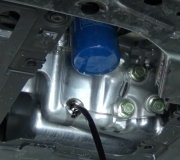Your father is being penny-wise and dollar-foolish. Saving a few bucks on oil will result in seriously decreased engine life. The oil is basically going to still be oil after 5,000 miles, but it's the additives that wear out. Those include seal conditioners, corrosion inhibitors, detergents, friction modifiers, and viscosity index improvers. Seal conditioners keep rubber seals soft so they don't get hard like a rock and crack from engine vibration. Corrosion inhibitors neutralize the acids that form in the oil from blowby fumes. (Antifreeze has similar corrosion inhibitors). Friction modifiers help the oil maintain its lubricating properties when it's really hot or cold. Oil lubricates by isolating internal engine parts from each other. When it stops doing that, the crankshaft and connecting rod bearings start contacting the crankshaft journals they're riding on. Once that metal-to-metal contact starts to take place, metal chips start to flake off and they further chew up those bearings. Viscosity index improvers allow oil to act like a thinner light-weight oil when it's cold, and it makes it act like a thicker oil at higher temperatures. That's why a multi-weight oil like 10W-30 is the best of both worlds.
The big one here is the detergents. They keep sludge-forming products suspended in the oil so it can be carried away to the filter. If you've been driving for three years without a working thermostat, there has been a huge amount of wear already done and the effects of not changing the oil will be multiplied many times. Engine parts are designed to expand and fit properly when the engine is fully warmed up. In particular, pistons are "cam ground" meaning they're oval, not round. As they heat up, they become round and fit perfectly. At that point almost no wear takes place. That's why fleet vehicles that run constantly get such high mileage. I just saw a right-hand-drive Jeep Cherokee mail truck with 600,000 miles and has never had any engine work done. Compare that to my step-father's Chevy Citation that was worn out at 66,000 miles when it went to the junkyard. The Ford he had before that needed the engine rebuilt at 40,000 miles and it was in the junkyard before 70,000 miles, again, with a worn out engine. But he saved a lot of money on oil changes.
To compound that excessive wear, normal blowby forms sludge in the oil which reduces its ability to lubricate, clean, and carry heat away. At normal temperatures that blowby vaporizes and is drawn out to be burned. When oil pans are removed from an engine that was running too cold, that sludge can be scooped up by hand and will feel and look like runny tar. That holds carbon particles and other grit that help to chew up engine bearings. Inside valve covers it will look like rustproofing material has been caked on.
Many synthetic oils advertise or recommend 5,000 mile oil changes. That's far different than when they were fairly new on the market and advertised "lifetime" oil. The additives that are compatible with those oils last longer before they're used up. The problem is that while that oil lasts twice as long, it costs three times as much as regular oil. Also, I've seen a few cases where switching to synthetic oil resulted in oil leaks. That's because the additives aren't compatible with petroleum-based oil. Engines that take five quarts of oil at an oil change actually hold about seven quarts. The other two don't drain out of the passages and places it pools in the block and on the heads. Often those leaks cleared up after switching back to regular oil.
Thursday, February 20th, 2014 AT 4:17 PM




